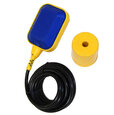MAC3 vs MAC5 Float Switches

Figure 1: MAC3 (left and middle) and MAC5 (right) float switches
MAC3 and MAC5 float switches offer precise liquid level control in various environments, including residential, industrial, and municipal applications. These float switches automate the management of liquid levels in tanks, cisterns, and pumping stations, ensuring efficient and reliable operation for both clean and wastewater management. This article explores the similarities and differences between MAC5 and MAC3 float switches, providing detailed technical insights to help users make an informed decision when selecting the most suitable float switch for their application.
View our online selection of MAC float switches!
When to choose a MAC3 or MAC5 float switch
When selecting between the MAC3 and MAC5 float switches, it is crucial to consider the specific requirements of the application.
-
Choose float switch MAC3 when:
- The application is for residential or industrial settings typically involving clean water
- The environment involves moderately loaded and turbulent conditions
- ACS certification is required for drinking water applications
- A versatile float switch is needed for both filling and emptying functions
-
Choose float switch MAC5 when:
- The application involves wastewater, sewage, or environments with high levels of grease and suspended solids
- The float switch needs to handle turbulent waters and challenging conditions
- The environment is potentially explosive, requiring ATEX certification
- A float switch with a built-in counterweight is necessary for optimal stability in turbulent conditions.
Read our float switch guide for more information on the working, materials, and types of float switches.
Similarities between MAC3 and MAC5 float switches
Both MAC3 and MAC5 float switches share several key features that make them reliable and efficient for liquid level control:
- Double-chamber design: Both models feature a double-chamber design, ensuring high resistance to shocks and preventing harmful infiltrations.
- High buoyancy thrust: Essential for applications with significant loads, ensuring reliable performance in turbulent and loaded environments.
- Changeover contact: Both MAC3 and MAC5 float switches have changeover contacts and can be used for filling and emptying operations (normally closed (NC) or normally open (NO)).
- Non-toxic polypropylene body: Both models are made from non-toxic polypropylene, making them safe for various applications, including drinking water.
- IP68 insulation degree: Both float switches have an IP68 rating, ensuring they are fully protected against dust and can withstand continuous immersion in water.
- Temperature range: Both models can handle fluid temperatures up to +50 °C (+122 °F), making them suitable for a wide range of liquid environments.
- Versatile applications: MAC5 and MAC3 float switches are suitable for a wide range of applications, including pumping stations, level control in tanks and cisterns, high-level alarm switches, and dry run protection.
- Piggy back plug: Both models can be equipped with a piggy back plug upon request. This accessory connects to the power supply and receives the pump’s plug, allowing the float to control the pump power.
Read our float switch wiring article for more details on MAC 5 and MAC 3 float switches wiring diagram and installation.
MAC3 vs MAC5: key differences
When comparing the MAC3 float switch to the MAC5, it's important to consider the specific requirements of the application.
Table 1: Differences between Mac3 and Mac5 float switches
| Feature | MAC3 float switch | MAC5 float switch | Significance |
| Microswitch type | 16(4)A 250 V~, 20(8)A 250 V~ | 10(3)A 250 V~ | The MAC3 supports higher current ratings, making it suitable for more demanding electrical loads, while the MAC5 is designed for lower current applications. |
| Dimensions | 106 x 154 x 54 mm | Ø117 mm, H222 mm, Volume 1000 cm³ | The larger dimensions of the MAC5 provide greater buoyancy and stability in turbulent conditions compared to the more compact MAC3. |
| Weight (without cable) | 234g | 1100g | The MAC5 is heavier due to its built-in counterweight, offering better stability in turbulent and challenging environments. |
| Switching angle | +20° / -45° | ±45° (±10° on request) | The MAC5 has a wider and adjustable switching angle, providing more flexibility and reliability in various liquid level control scenarios. |
| Nominal pressure | 1 bar (14.5 psi) | 2 bar (29 psi) | The MAC5 can handle higher nominal pressure, making it more suitable for high-pressure environments compared to the MAC3. |
| Cable lengths | 2, 3, 5, 10, 15, 20 m | 5, 10, 20 m | The MAC3 offers more cable length options, providing greater flexibility in installation compared to the MAC5. |
| Standard cables | PVC 3X1, H07RN-F 3X1 | PVC 3X1, NEOP.H07RN-F 3×1, H07BN4-F 3×1 | The MAC5 offers additional cable types, providing more options for different environmental conditions and durability requirements. |
| Built-in counterweight | No | Yes | The built-in counterweight in the MAC5 enhances stability in turbulent waters, making it more reliable in challenging conditions. |
| Certifications | ACS certified version available | ATEX certified version available | The MAC3 is available with ACS certification for drinking water, while the MAC5 is available with ATEX certification for use in potentially explosive environments. |
| Accessories | Counterweight, Piggy back plug | Bracket, piggy back plug | The MAC3 includes a counterweight for fixing the float’s range of movement, while the MAC5 includes a bracket for fixing multiple floats, enhancing installation flexibility. |
Read our sump pump, sewage, and water tank float switch articles for more details on the specific applications of float switches.





